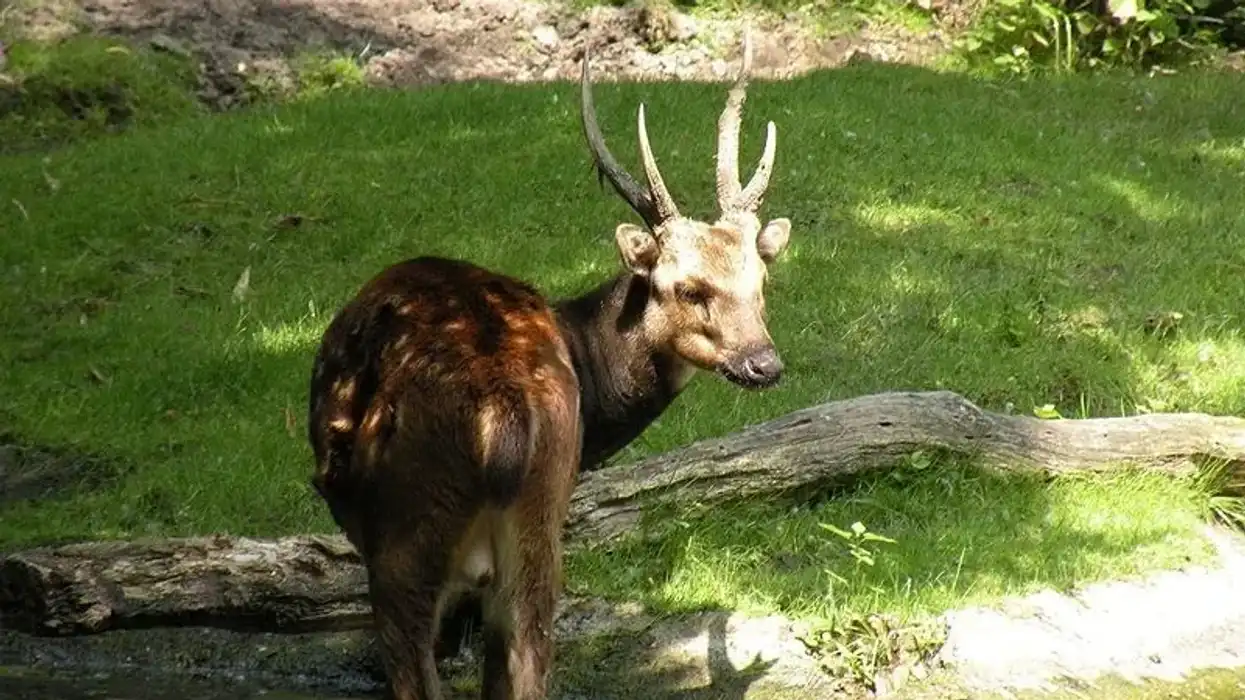A small passerine bird in the white-eye family, the Indian white-eye (Zosterops palpebrosus) is a resident breeder that is found primarily in the Indian subcontinent. The species was formerly called the Oriental white-eye. In 1824, the species was described by the Dutch zoologist Coenraad Jacob Temminck.
Both males and females look similar, and the species generally possesses either yellowish-olive or green upperparts and a white eye-ring. Its bill is quite sharp and is black in color. Its throat and vent are yellow while its belly is whitish-grey. The average body length of the species is around 3.14-3.54 in (8-9 cm).
The range of these Oriental white-eye birds includes India, Pakistan, Sri Lanka, China, and Indonesia. A vagrant population has also been observed in Hawaii, the United States.
These birds inhabit lowland forests, mangrove areas, and moist forests, and they have also adapted to live in villages, farms, and parks. The International Union for Conservation of Nature has listed the species in the Least Concern category. The species faces threats like predation and habitat loss.
For more relatable content, check out these canyon wren facts and American pipit facts for kids.
Indian White-Eye Interesting Facts
What type of animal is an Indian white-eye?
The Indian white-eye (scientific name: Zosterops palpebrosus) is a small passerine bird that is a resident breeder in open woodlands of the Indian subcontinent. Coenraad Jacob Temminck, a Dutch zoologist first described the bird in 1824. The species is best known for its alluring white eye ring.
What class of animal does an Indian white-eye belong to?
The Indian white-eye (Zosterops palpebrosus) belongs to the class of Aves, the family of Zosteropidae, and the Zosterops genus. The species was formerly called the Oriental white eye.
How many Indian white-eyes are there in the world?
The exact population size of the Indian white-eye (Zosterops palpebrosus) is not known as of now but it is quite large. Populations of these birds are widespread and are found in different parts of Asia. Also, these birds are listed as a species of Least Concern in the IUCN Red List.
Where does an Indian white-eye live?
The Indian white-eye range includes India, Pakistan, Sri Lanka, China, and Indonesia, and a vagrant population has also been observed in Hawaii, the United States. Previously, the range extended eastwards to southeast Asia, Malaysia, and Indonesia.
What is an Indian white-eye's habitat?
The typical Indian white-eye habitat includes lowland forests, mangrove areas, and moist forests. These birds have also adapted themselves to live in villages, farms, and parks. Drier desert regions of western India also serve as habitats to this Oriental white-eye species.
Who do Indian white-eyes live with?
The Indian white-eye (Zosterops palpebrosus) is a sociable bird that is found in small groups or flocks. These groups generally separate at the onset of the breeding season. These birds rarely form large groups but they keep foraging together and calling each other continuously.
How long does an Indian white-eye live?
The average lifespan of the Indian white-eye (Zosterops palpebrosus) is not known as of now but a similar bird species of pale white eyes is known to live for around eight years. The bird can live for around 10 years in captivity.
How do they reproduce?
These small birds generally follow a monogamous breeding pattern which means they mate for life. The breeding season occurs from February to September and peaks in the month of April.
During the breeding season, a hammock-shaped nest made up of cobwebs, lichens, and plant fiber is placed on the fork of a branch. This period also marks the beginning of several courtship displays.
An Indian white-eye male performs loud songs for several minutes during the day and the evening. Soft warbles and areal shows are also performed to coax the female.
It takes around four days to construct the nest and both the Indian white-eye female and male are involved in incubating the eggs. The incubation lasts for around 10 days. Around two eggs are laid within a couple of days of each other and the color of these Indian white-eye eggs is pale blue.
What is their conservation status?
Populations of Indian white-eyes are not under any threat, even the International Union for Conservation of Nature has listed the species in the Least Concern category. These birds are generally affected by predation and habitat destruction, so if deforestation continues, the species might become vulnerable.
Indian White-Eye Fun Facts
What do Indian white-eyes look like?
A species of the Zosteropidae family, the Oriental white-eye (Zosterops palpebrosus) species is best known for its white eye-ring. The bird generally has either yellowish-olive or green upperparts, the bill is black and quite sharp, the throat and vent are yellow, and the belly is whitish-gray.
How cute are they?
As well as the beautiful Indian white-eye appearance, their songs and social behavior are enough to put a smile on anyone's face. The male bird can sing for several minutes to grab the attention of a female.
How do they communicate?
Like other species of the Zosteropidae family, the Oriental white-eye (Zosterops palpebrosus) communicates with loud contact calls that are used to find each other. Several musical notes are also used during the breeding season. Adults generally groom the feathers of their offspring and their mates to strengthen their bond.
How big is an Indian white-eye?
The Oriental white-eye (Zosterops palpebrosus) is a small bird and its average body length is around 3.14-3.54 in (8-9 cm). The average Indian white-eye wingspan is not known but the species is bigger than both bee hummingbirds and ruby-crowned kinglets.
How fast can an Indian white-eye fly?
The average Indian white-eye flight speed is not known as of now, but the species is known to be a strong flier. The bird is highly arboreal and rarely comes to the ground.
How much does an Indian white-eye weigh?
The exact weight of Indian white-eyes (Zosterops palpebrosus) is not known as of now but the species easily gets dispersed in strong winds and storms, suggesting it is not very heavy.
What are their male and female names of the species?
There are no specific names for male and female Oriental white-eye (Zosterops palpebrosus) birds. Also, no clear signs of sexual dimorphism have been gathered yet.
What would you call a baby Indian white-eye?
A baby Oriental white-eye (Zosterops palpebrosus) is known as a chick.
What do they eat?
Like other species of the Zosterops genus, the average Indian white-eye diet includes small insects, fruits, nectar, and seeds. The Zosterops palpebrosus species is preyed upon by birds such as vampire bats and common kingfishers.
Are they dangerous?
The Zosterops palpebrosus species is generally not considered dangerous but they can attack if someone tries to threaten or provoke the bird.
Would they make a good pet?
No, Zosterops palpebrosus birds do not make good pets easily as they belong in small groups foraging in the wild.
Did you know...
There is little evidence that these birds migrate, but in the '80s, a feral population of this bird species was detected in San Diego, California.
How did the Indian white-eye get its name?
Their name (white-eyes) comes from the ring of white feathers around their eyes, while the term 'palpebrosus', from the scientific name, Zosterops palpebrosus, means 'having prominent eyelids.'
Is the Indian white-eye endangered?
No, the species is not endangered. In fact, studies reveal that their population size is large.
Here at Kidadl, we have carefully created lots of interesting family-friendly animal facts for everyone to discover! Learn more about some other birds from our Hawaiian honeycreeper facts and umbrellabird facts pages.
You can even occupy yourself at home by drawing one on our free printable Indian white eye coloring pages.









